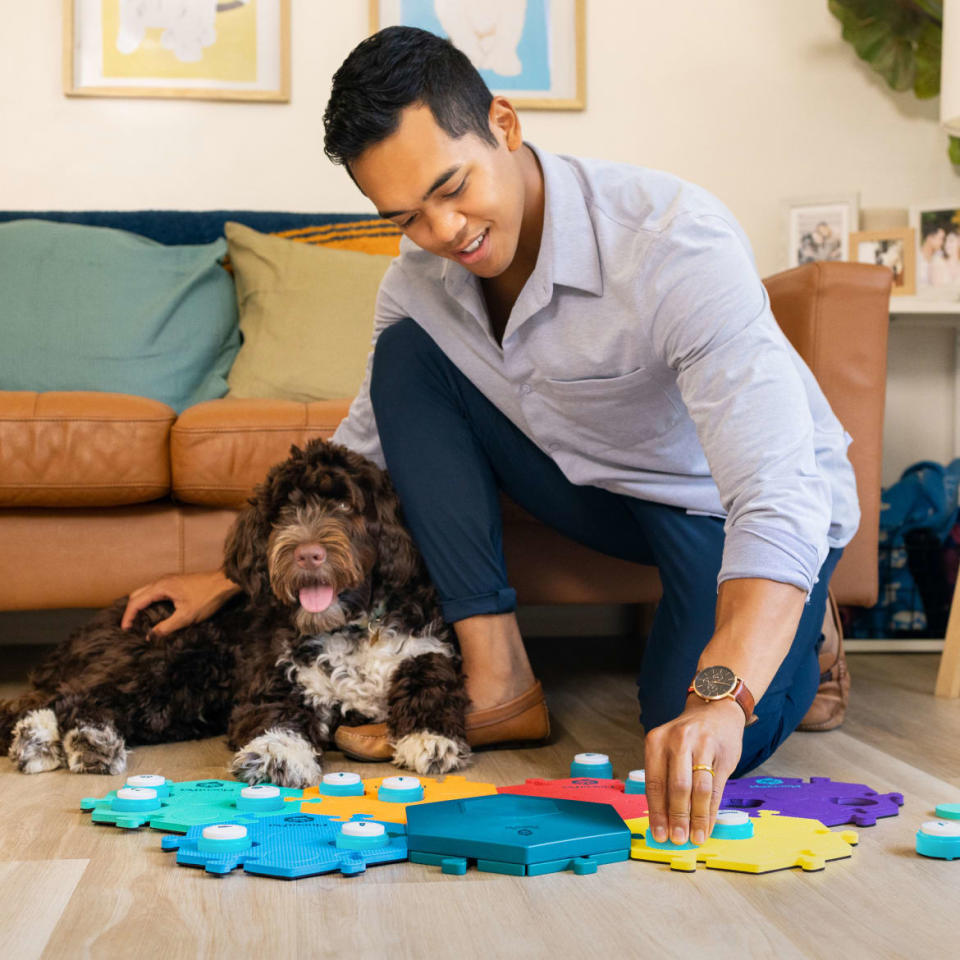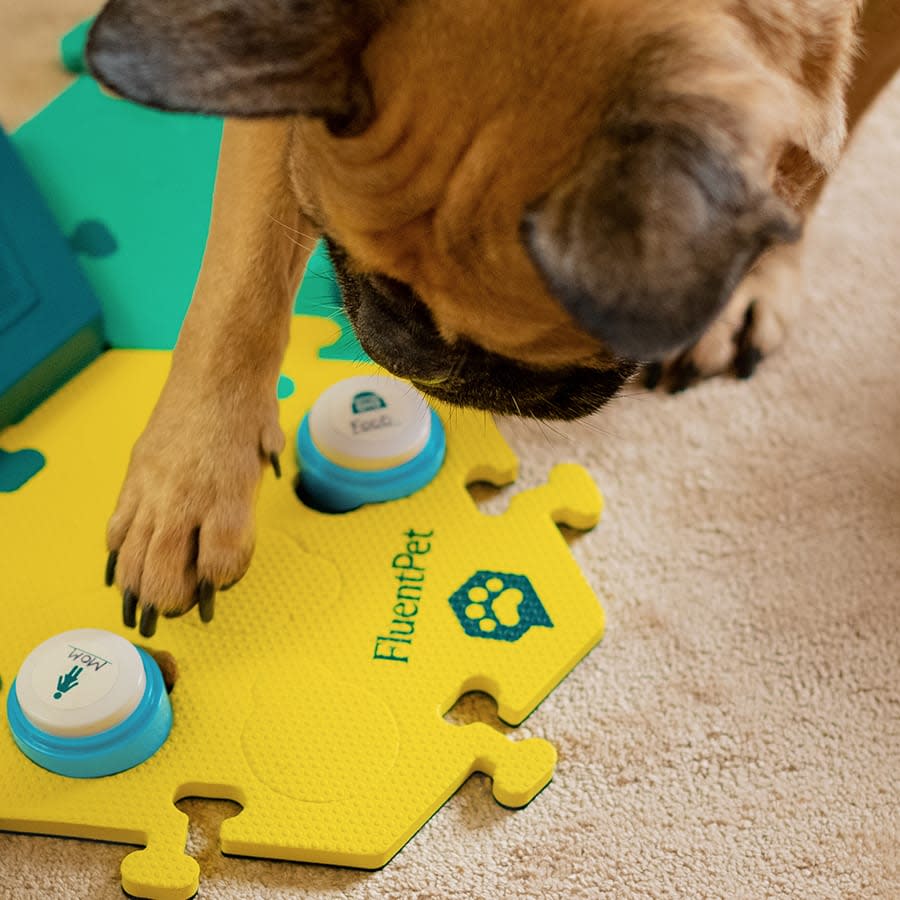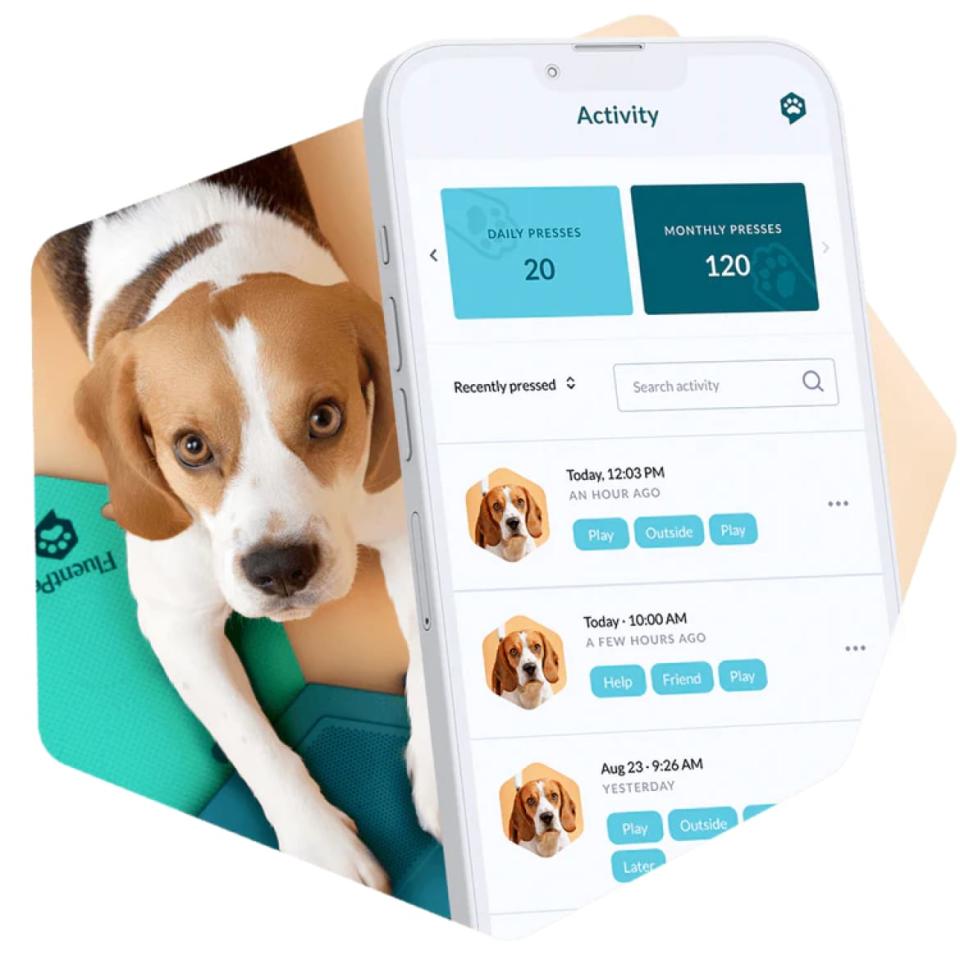Can This Viral TikTok Device Let You ‘Talk’ to Your Dog?

It’s hard to flip through animal videos on social media without coming across the hexagonal buttons made by FluentPet, a start-up determined to help animals talk to humans. The company’s patented product allows animals to “talk” by pressing individual buttons, each of which produces the sound of a single word or phrase, like “play” or “outside.”
The result, at least in the context of TikTok and Instagram, has been an endless stream of videos in which animals string together several words in a similar cadence to Apple’s Siri, assuming she’d been dropped in water first. The platforms are now heavily saturated with videos of dogs having existential crises, cats engaging in emotional blackmail, and even the occasional horse attempting interspecies communication.
Such videos have helped FluentPet to sell more than 2 million buttons since its launch in June 2020. But dominating social media is not the only goal of the pet-focused startup, which outlined plans to power a dog-based economy in a patent granted to the company in 2022. “Dogs already make excellent aids in a security context, in helping with patrols,” the patent reads. “With rudimentary language abilities, dogs could potentially even replace humans in this role—or at least operate with a higher ratio of dogs to human handlers.”
FluentPet CEO Leo Trottier, a cognitive scientist, entrepreneur, product designer, and software engineer based in San Diego, California, is excited about that very possibility. “I would love it if there was a dog that hung out at the front [of my apartment building], greeted people and said hi to people—maybe even let in the Amazon delivery guy,” Trottier told The Daily Beast.
He believes most consumers would readily accept doggy doormen, assuming that costs were kept low. “I strongly suspect that the people who want a doorman are not going to be like ‘Mmmm, I’m not going to accept this dog downgrade, I want someone to tip their hat at me!’, y’know?”
Of course, the rise of a dog-based labor market would not come without economic consequences. Goldman Sachs has predicted that artificial intelligence—which has seen huge investment in recent years from companies looking to cut costs—could replace the equivalent of 300 million jobs through automation. Although it’s hard to say whether or not those same companies would adopt four-legged employees with as much gumption, such developments may not bode well for security guards or doormen judging from FluentPet’s patent.
However, Trottier is adamant that the threat of canine competition in the workplace cannot be compared to AI. “Communication with dogs would enable what I think far outclasses and exceeds the kinds of labor replacement that we see software accomplishing,” he said.
Trottier explained that animals differ from software through their physical needs: They require shelter, food, “cuddles in the evening,” and general care. He asserts that their participation in the labor market would in fact create more jobs for humans that most people would enjoy. “The jobs in the military and in the police force that everyone wants are the ones that involve interacting with dogs,” he added, “because dogs are so fun to work with.”

Some experts say that the animals are simply learning to associate FluentPet buttons with specific actions like “walk” or “fetch.”
His statements echo those made by tech giants like Open AI CEO Sam Altman, who claimed in September last year that AI would help people to do their jobs in a more efficient way, eventually resulting in “new and better jobs” for humans once AI could fully replace them. But those new jobs seem far and few between, as the tech industry has spent the last few months laying off hordes of its human workers while simultaneously pouring billions of dollars into AI.
Trottier wants to be clear that mass displacement of workers is not part of FluentPet’s business model, despite the promotion of cost-saving dog-ployees in its patent. “It’s not part of our vision to make that possible,” he said. “These are just some of the possibilities that we describe in that document.”
The patent is certainly full of possibilities. It contains all kinds of suggestions about a world revolutionized by FluentPet: dogs that are able to alert humans about impending earthquakes, drug dogs that can tell police officers exactly which drug they’ve picked up the scent of, increased spending on pet products from dogs that can verbally demand new toys, and even a form of FluentPet-enabled dog telepathy. It raises questions about the aims of the company, its plans for the 8 million points of data collated by its dedicated user base of pet owners and animals, and what those things could mean for the future of automation.
Old Dogs, New Tricks
One of the more fantastical ideas in FluentPet’s patent is its potential future plans for its button-based technology. The document outlines a process in which AI would be trained to track the brain activity of dogs while they use FluentPet buttons, eventually resulting in a system which would predict which button a dog was thinking about pressing before it pressed it. These dogs would have AI-enabled abilities akin to telepathy, allowing them to communicate—or even operate smart home systems attached to doors and food dispensers—just by thinking.
When asked, Trottier did not clarify whether or not “dog telepathy” was an accurate depiction of what the patent suggests. “I will say that it would be very valuable if it was possible for dogs to be able to use the buttons without needing to touch them physically,” he said, “because then they could use them anywhere.”
It may not be the only hidden value in FluentPet’s patent. The company has partnered with UC San Diego’s comparative cognitive science department since 2021, in a collaboration led by cognitive scientist Federico Rossano. The partnership largely involves the study of FluentPet’s data, which is voluntarily recorded through an app by thousands of users worldwide, to better understand the animal’s button pressing.
In general, AI is closely linked to cognitive science as the models which inform things like neural networks and reinforcement learning are based on animal brains. Rossano has published studies on both animal cognition and AI, including a paper on a possible model that would help robots and humans develop shared goals.

The pet-focused startup FluentPet outlined plans to power a dog-based economy in a patent granted to the company in 2022.
Trottier is a graduate of University of Toronto’s Cognitive Science and AI program, where he studied alongside Dr. Timothy Lillicrap, a top researcher at DeepMind and investor in FluentPet; Lillicrap has developed algorithms based on animal cognition that help AI to produce images from prompts, play games, and recognize images.
Could the real value of FluentPet’s data and brain mapping plans be in the development of robots and more advanced AI? Rossano certainly thinks so. He told The Daily Beast that using data collected from animals can act as a building block for creating more advanced AI.
“You don’t start by trying to understand how people can build a rocket ship. You start by trying to understand how simpler creatures do a limited range of activities, so that the range of behaviors to identify are smaller and more manageable,” Rossano explained. Much like a puppy being taught new tricks, AI-in-training has to start off with smaller, less complex information before graduating to human-based datasets. “You start from something simpler,” Rossano said, “and then you can scale it up.”
Rossano—who is leading a range of independent and FluentPet-linked research on AI and animal behavior—also explained how valuable dog-like AI could be. “A lot of these models, we don’t really know what they’re doing. We see the outcomes, but we don’t know if they’re also simultaneously deciding to eliminate us from the face of the Earth,” he said.
Dogs, on the other hand, are predictable, understandable, and trusted by humans in a way machines currently aren’t. “This research is another way of trying to understand if you could model this type of relationship, would that be a potentially safer type of AI than other people are currently working on?”
Eventually, all of this could lead to a monumental outcome: AI that has overcome the “black box problem,” or the inability for humans to see how a deep learning model makes decisions, or comes to certain predictions and outcomes. “We’re trying to figure out what’s going on, what it is that they’re doing, so that we could potentially get to some mutual understanding and a value alignment,” Rossano said.
Barking Up the Wrong Tree
Of course, making some of these scientific strides requires precise and accurate data. Trottier admitted that even FluentPet can’t be certain that people aren’t faking their talking pets. “We can’t be 100 percent sure who is touching the button. Maybe they have a baby touching the button. Maybe [the owner is] pressing the button. Maybe they have a Roomba that's riding over the button. No one really knows,” he said.
He hopes to one day overcome this issue with the use of cameras, and believes that both FluentPet itself and the community that exists around it have got better at identifying “inauthentic” communication from dogs. Such dogs can apparently be spotted because they are watching the human who is filming them for signals and commands, rather than thinking for themselves.
The “thinking”, according to Trottier, often looks like spinning, or a “thinking circle” that dogs use engage in when considering which button to press, as performed here by Bunny the Dog. “Frankly, I think it’s probably a small fraction of [button presses] that are done by humans now.”
Whether the true button presses are accurate to begin with is another thing entirely. Last year, TikTok user Yuval Ben-Hayun claimed to have examined more than 70 videos of Bunny The Dog, FluentPet’s most famous user, who has amassed more than 10 million followers across TikTok, YouTube, Facebook, and Instagram. In the video, Ben-Hayun criticized Bunny’s owner for her interpretation of button presses—such as translating the combination of “tug” and “water” to mean “high tide”—for being too generous.

FluentPet is gathering data from thousands of app users worldwide, to better understand animals’ button pressing.
“Bunny is not just communicating. She is just pressing completely random buttons,” Ben-Hayun said in the video, “and the parts that are not random are nowhere near anything that you should call language.”
Bunny the Dog is officially associated with FluentPet as a “guide”: animals successfully using buttons to communicate that sign agreements with FluentPet and act as models to the rest of the talking pet community. According to Trottier, they are held to high standards and monitored for signs of trickery.
“The button users that at least FluentPet associates with are assuredly not faking it,” Trottier wrote in an email to The Daily Beast. “All Guides agree to a set of Guide guidelines that emphasize honesty in the presentation of button pressing behaviors. If we were ever to catch wind of a guide engaging in trickery or scripting to produce a deceptive video, we would immediately terminate our association with them.”
Bunny the Dog’s owner, Alexis Devine, did not immediately respond to requests for comment on Ben-Hayun’s video.
But experts still aren’t completely sold on FluentPet’s accuracy. Irene Pepperberg, an adjunct research professor at Boston University who has devoted her career to studying animal cognition and communication in grey parrots, views FluentPet as an “excellent” source of enrichment for companion animals.
But Pepperberg explained in an email to The Daily Beast that pets like Bunny were simply learning to associate FluentPet buttons with particular actions like “walk” or “fetch” to achieve a very basic level of communication with their owners. “Is it anything more? I doubt it,” she said.
Trottier conceded that the science needed to back up things like Bunny the Dog’s existential crises isn’t quite there yet. “Scientifically proving meaningful symbol-based communication between humans and other animals is an exceptionally high bar, and if this kind of communication is possible, it will take time to clear this high bar,” Trottier wrote in an email to The Daily Beast. Trottier also wrote that such an achievement would be “paradigm shifting” and “perhaps as impactful as humans landing on Mars.”
He went on to argue that the potential for animals to learn language has been well-documented, citing dogs like Rico, a border collie dog that learned the sounds corresponding with 200 unique objects. Such research has been “historically fraught” because of the small numbers of research subjects previously involved, he explained.
“We believe that an alternative approach that brings to bear hundreds, or even thousands, of participants might have a chance of shedding new light on [talking animals],” Trottier wrote.
Rossano, meanwhile, stressed the importance of not communicating anything until the publication of peer-reviewed scientific papers. “Those papers are under review, and I’m not going to tell people what we’ve found until the papers are approved by the scientific community,” he said. “We're trying to be careful about what kind of claims we make, because putting forward strong claims based on insufficient evidence could be dangerous.”
How AI Can Help Treat (and Cure) Your Dog’s Cancer
This means we could be a long way from some of the more grandiose possibilities outlined in FluentPet’s patent, which rely on dogs being able to communicate accurately. Some of the most outlandish plans include the development of “scent-capture” buttons which can allow dogs to successfully diagnose diseases by smell. There are even suggestions about the ability of dogs to testify in court in the context of animal abuse cases.
“While it is anticipated that the various tests for admissibility of evidence may take a long time to accept dog testimony in court, it may be treated in the same way as a lie detector test,” the patent reads. “That is, it may help investigators to rule in or rule out possible suspects.”Trottier had little to say about the development of such technology by FluentPet, although he did admit that the idea of dogs diagnosing conditions or illnesses through scent was “very exciting.” However, he was far more interested in focusing on what the power of talking dogs could do for society.
“I think we believe that no one goes beyond their potential, as though we have some idea what human potential is,” Trottier said. “In my ideal scenario, accomplishing this [mission of teaching pets to speak] with non-human animals multiplies our ideas of what human potential might be by a hundred times.”
Besides, wouldn’t the world simply be a better place if our pets could really talk? “In fantasy novels, you’ve got dogs and cats, and they’re not humans—they have a distinct role in society, but they also kind of talk to you,” Trottier said. “We fantasize about this, and I think that would be great.”
“If most or every dog or cat was almost like a little familiar, that could be your buddy, how much less lonely would we be?” he continued. “It’s just such a rich and exciting future. That’s what I would love to see happen.”
Get the Daily Beast's biggest scoops and scandals delivered right to your inbox. Sign up now.
Stay informed and gain unlimited access to the Daily Beast's unmatched reporting. Subscribe now.

